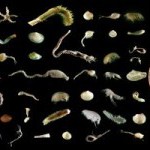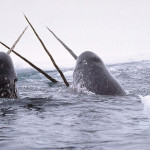The first new 25 Things at Sb! So grab a cup-o-joe and read on!
The extremes of the physical deep-sea environment (temperature, pressure, and lack of light, low food) are more than a challenge for deep-sea organisms. Unfortunately, there is one more-disturbance.
In ecology, hypotheses for how biodiversity is maintained generally fall into two categories, equilibrium and nonequilibrium. Equilibrium hypotheses typically focus on processes that promote partitioning of the environment that lowers species competition and coexistence (the competitive exclusion principle). These hypotheses assume competition will occur because the biological community is near carrying capacity (i.e. the number of individuals the environment can support). For nonequilibrium hypotheses, the focus shifts to disturbance and other processes that keep populations well below carrying capacity.
One of the earliest hypotheses to explain the presence of a great number of species in the deep sea was the equilibrium hypothesis of Sanders (1968). Sanders proposed the Stability-Time Hypothesis stating that deep-sea environments were physical stable, i.e. no disturbance, allowing for organisms to evolve toward specialization. These adaptations lead to organisms finely dividing the environment (i.e. narrow niche breadth). The hypothesis was largely bolstered by bottom photography of a monotonous mud seafloor and a perceived lack of oceanic disturbance. The current understanding of deep-sea environments was an environment buffered by 1000’s of meters of water from climate change and mass extinctions.
Our current understanding of deep-sea systems is much different and the Stability-Time Hypothesis has largely been abandoned.
We now understand the seafloor as dynamic environment disturbed from small to geologic time scales. Some areas of the seafloor can experience strong bottom currents. At the shortest time scales, large organisms can disturb the sediment as they forage. Megafaunal processing of sediments through ingestion has been estimated to by one study to be 100 g of sediment d-1 (Deming and Colwell 1982) and in another 1500 ml of sediment m-2 yr-1 (Smith et al. 1986). Tidal fluxes can also reach depths greater than 200m. Seasonality of ocean production and El Nino effects can be transmitted to the deep sea. Because El Nino/Southern Oscillation affects surface production and deep-sea ecosystems are completely reliant on this as a food supply, one can envision there being a fairly decent signature of ENSO on deep communities. ENSO forcing can dictate the upper boundary of oxygen minimum zones in the deep sea that pervade the east Pacific. Researchers have shown off Chile, ENSO events lead to greater oxygenation of bottom water and a reduction of food quality/quantity from overhead. Research also indicates that some groups may actually increase densities after an El Nino while others decline (Ruhl & Smith 2004).
Against this backdrop are episodic events such as benthic storms, sediment slides, slumps, debris flows, and earthquakes. Eddies cast off the Gulf Stream can reach the bottom and generate benthic storms that can persist for several days. Sediments slides and slumps can occur where the elevation is only 2 degrees, while sluggish debris flows can occur at angles as small as 0.5 degrees. Down slope in canyons, high velocity density currents can carry a mixture of sediment and water. These turbidity flows have amazing power and can move sediments (or deployed gear!) several kilometers away. Earthquakes can also cause sediment slides or significantly change bottom topography as demonstrated by the recent activities in Asia.
So why is diversity high in the deep sea?
Share the post "25 Things You Should Know About the Deep Sea: #14 The Deep Sea Is Not Stable"






I think your point on the importance that various organisms can have on sediment movement is an often overlooked sediment transfer mechanism. For a terrestrial example, think of how much sediment is move (or stopped) by beaver, praire dogs, and bison.
From the MBARI link:
The MOOS Science Experiments, planned for 2004/2005 will attempt to measure the flow of materials and carbon in the lower canyon near Shepard Meander near 3500 m. It will be interesting to see if the upper canyon events penetrate to near the abyssal plain.
Was this carried out and if yes, what were the results?
The Monterey Ocean Observing System (MOOS)is actually a variety of projects and feats of engineering. The system is a surface bouy that is connected to the seafloor via cable. The bouy is able to link with a satellite and relay data from the ocean floor back to the institute. Obviously this is a major technological feat and ‘bugs’ had to be worked out. My current understanding is that the main system is in place and going through the final checks. Data aquisition is still in the future.
http://www.mbari.org/moos/
Check out this excellent video on Marie Tharp…the famous oceanographer who died ths year.
http://video.on.nytimes.com/?fr_story=8553e155bef2185ef71a570e2c83a1d38ce8f576&rf=bm
Thanks Frank! Will elevate the link to a post.
Isn’t this “25 Things you need to know” a great series?
Only 11 more “Things” to go…
A relevant article on eddies here:
http://deepseanews.blogspot.com/2006/03/eddies-cause-fast-deep-sinking.html
A little more on turbidity flows in submarine canyons here:
http://deepseanews.blogspot.com/2006/11/cascading-flows-in-submarine-canyon.html